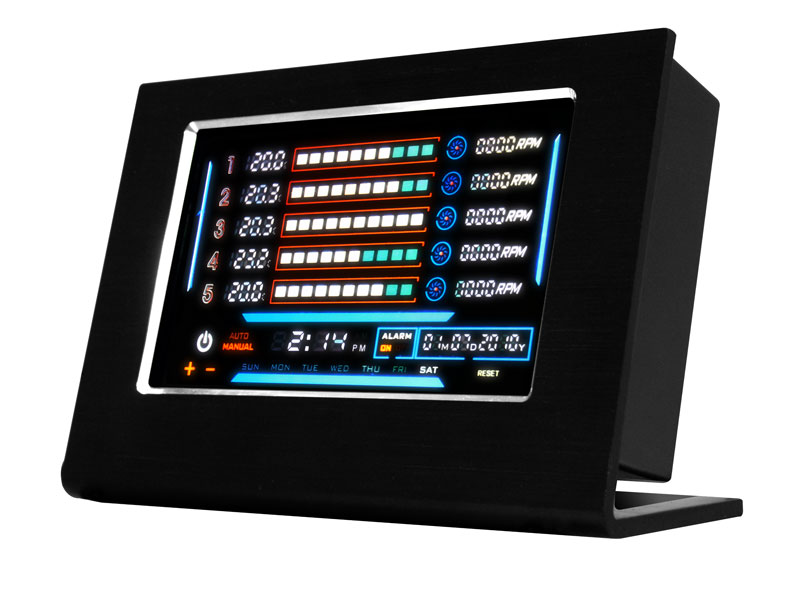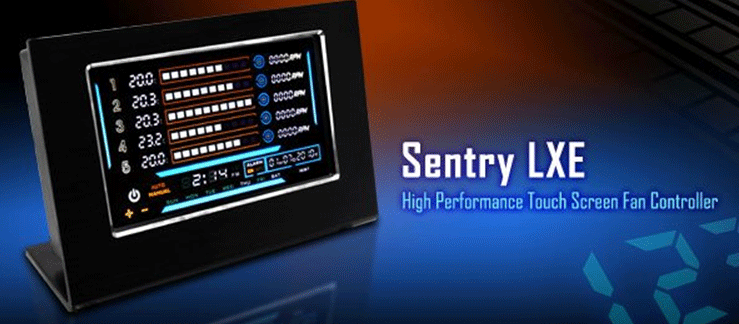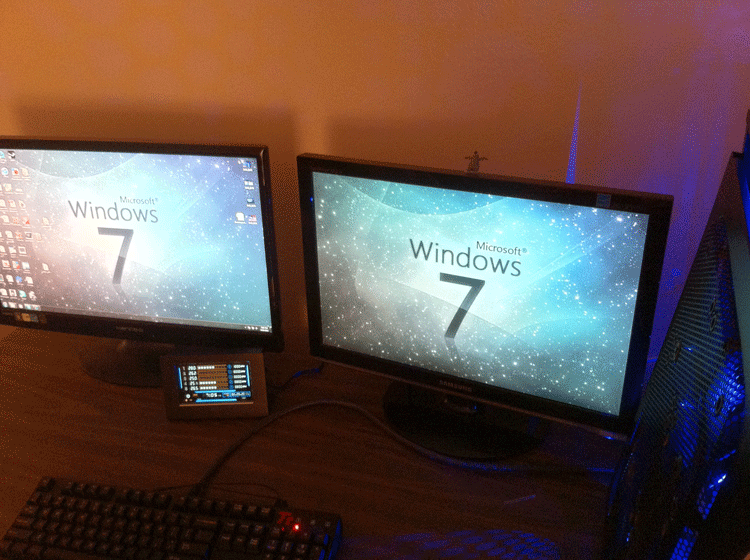The NZXT Sentry LXE is specifically designed for user convenience. Unlike other fan controllers it is unique and is not restricted to either PCI or 5.25″ format, and has an interactive touchscreen design.
Introduction
In the past, the importance of fan controllers was commonly questioned, since motherboards were capable of providing sufficient fan control to ensure proper air cooling. With the recent development of more powerful components that run significantly hotter, the need for a better air circulation has increased drastically. While air cooling can rival water cooling in efficiency and the amount of noise produced, the price difference commonly serves as a deciding factor for those who choose air over water cooling. Fan controllers are capable of supporting additional fans that will ensure that air circulation is dynamic throughout the case, while providing a minimum level of noise. While fan controllers are mostly made simply to control the speed of various fans, several companies have taken the liberty to introduce innovative features to fan controllers, making them the ultimate air circulation control machinery. Through addition of special features like various control mods to provide efficient cooling with the lowest noise ratio and thermal sensors that allow for the user to assess the cooling throughout the case, fan controllers are capable of accomplishing the tasks previously relayed to the motherboard throughout the case.
While there are many different fan controllers currently available on the market, some companies have taken on the initiative to evolve their fan controller products to a completely new level. NZXT is among the few and has previously released two touch screen fan controllers: Sentry 2 and Sentry LX. Both fan controllers have a touch screen interface and are mountable into a 5.25″ slot in the front bezel of the case. Today, we will take a look the newer and third fan controller in the NZXT Sentry line: the Sentry LXE, priced at USD 59.99 nn Newegg.com. Unlike its predecessors, this fan controller is not restricted to the front slot in the bezel of the case. Connected through PCI-E slot in the back this fan controller can be moved around and placed in a convenient spot for the user, whether it be on a table or top of the desktop. This is certainly a unique feature that fan controllers have not previously been observed with. Stay tuned as we take a closer look at this fan controller.
Features
- Intuitive Touch Screen LCD – Advanced, touch screen LCD displays temperatures in C/F, RPMs, along with the date, time, and day of the week. Users have the ability to switch the display off for complete darkness for more immersive gaming sessions
- Complete Control – 5 Temperature Probes keep tabs on thermals throughout the case while the 5 Fan controllers adjust the fans’ RPM speed for at least 10W per channel. Allows users to automatically adjust the fan speeds to correspond to a specific temperature, manually customize for extreme overclocking capabilities, or set to absolute silence
- Temperature Alarm – Instant notification if temperatures rise above a designated point
- Sleek Design – Brushed aluminum frame provides sleek aesthetics for any desktop.
- Rechargeable Battery – The Sentry LXE features a rechargeable battery for up to 500 times, keeping the LXE life time longer without the hassle of replacing batteries constantly.
- Convenient external LCD Monitor Design – Using an NZXT-developed PCI board and external touch display, the LXE allows for more 5.25″ bays freed up for other peripherals.environment. Simply set the fan controller atop your PC or desktop and connect through PCI card interface.
Specifications
| Fan Adjustment Range | 3.7V to 12V |
| Fan Channel | 5 |
| Max watt per channel | 10W |
| Temperature Module Channel | 5 |
| Temperature Range | 0 ~ 99℃ / 32 ~ 199.9℉ |
| Measurement Frequency | Every 2 Seconds |
| Temperature Alarm Range | 30℃ to 90℃ |
| (AUTO) | Min 50%, Under 0-25℃,fan RPM 50% |
| (MANUAL) | Min 40% |
| Screen Size | 5.27 inches |
| External Cable Length | 6.8 feet |
Pictures & Impressions
NZXT Sentry LXE comes in a rather standard packaging. The front of the packaging contains the picture of the product as well as several features that the product has to offer. The name of the product and company are also clearly relayed, bringing across a clear message of what the product is The back of the packaging expands on the specifications and features and is written in several languages,demonstrating that this product is clearly geared towards a diverse specturm of consumers.
Inside the box the consumer will find several components, including the touchscreen controller itself, a PCI-E card and supplementary material required for the installation of the product. Since the only component that is prone to physical damage is the LCD monitor, NZXT has packaged the monitor inside styrofoam on both sides in order to ensure that it will not be damaged during delviery.
The LCD monitor itself looks really sleek and professional. The whole enclosure is made from brushed aluminum, which is definitely a high quality material in comparison to commonly expected plastic. The dark tone contrasted with the silver lining of the actual LCD monitor looks rather appealing to the eye. Overall the monitor is rather sturdy and is more likely to slide back across a surface than it is to tip over. On the back of the monitor the user will find an 8-pin power connector, which is used to connect through the power cable in the back of desktop.
From the first look the PCI-E card, which comes with the NZXT Sentry LXE, looks somewhat crowded with wires. Altogether there are a total of 11 wires connected to the card including 5 fan connectors, 5 thermal sensors and a single 4-pin power cable. Managing the wires inside the desktop can prove to be a problem, but depends on the cable management skills of the user, the quantity and placement of hardware, and the size of the case. The NZXT Sentry LXE does come with the tape for the thermal sensors, which allows for the user to easily secure the sensor in place.
The overall layout of the card is rather simple but has definitely never been observed in other fan controllers. The card does not draw power directly from the PCI-E interface, but rather requires the use of the provided 4 pin power cable. An additional space for 3.6V battery is also made on the card. We assume the battery allows the monitor to keep up with the time. Since the Sentry LXE has its own timer and calendar, addition of the battery is certainly something that has not been seen before. From the outside of the PCI-E card the user must connect an 8 pin power cable (included in packaging) to the monitor.
Testing & Methodology
While there is no solid procedure for testing a fan controller, and the performance of the fan controller depends solely on the quality of the fans, a variety of tests were done in order to ensure objective testing. Both modes of Sentry LXE, auto and manual, were tested to see the speed of response and change in the fan speeds. In Manual mode the fan speeds changes were dependent upon various situations and the response was measured by comparison of the speed obtained through HW monitor and the speed observed on the Sentry LXE. Auto mode testing was based on the ability to thermal sensors to detect temperature and illicit appropriate response resulting in change of the fan speed.
|
Test Rig |
|
| Case | In-Win Dragon Rider |
| CPU |
Intel Core i7 930 @ 3.8GHz |
| Motherboard |
GIGABYTE G1. Sniper |
| RAM |
3x 2GB Corsair 1333MHz |
| CPU Cooler | Thermalright True Black 120 with 2x Noctua NF-P12 Fans |
| Drives |
3x Seagate Barracuda 1TB 7200.12 Drives RAID 5 |
| Optical | ASUS DVD-Burner |
| GPU |
Palit GTX 560 Ti Sonic ASUS ENGTX 560 Ti |
| Fan Controller | NZXT Sentry LXE |
| Case Fans |
3x Noctua NF-P12 Fans – Side 3x In-Win 120mm Fans – Front, Back, Top |
| PSU |
SeaSonic X750 Gold 750W |
| Mouse | Cyborg RAT 7 |
| Keyboard | Thermaltake Meka G1 |
Manual Mode Testing
Fan speed of Noctua NF-P12 120mm was changed from 1300 rpm to 0 rpm by using NZXT Sentry LXE LCD monitor. The amount of time required for the change to take place was recorded using a stop watch. The timer started counting from the point when the LCD monitor was touched and stopped when fan movement stopped completely.Same procedure was done for testing of the fan in inactive state (0 rpm) to its standard working potential (1300 rpm)
| RPM change | Time (sec) |
| 1300 rpm to 0 rpm | 10.3 |
| 0 rpm to 1300 rpm | 7.8 |
As the results show, the change occurs rapidly, within 10 seconds. The reason for the delay is the amount of time required from the user to adjust the settings by using the LCD monitor. While LCD response is rather sensitive to the touch the delay may result in slightly slower response than with a simpler fan controller. However, it is not a major issue, and still indicates that this fan controller has fast response.
Auto Mode Testing
For this testing, Sentry LXE fan controller was set to run the 3 fans on the right side panel of the case close to the 2x GTX 560 GPUs overlocked to 1 GHz. Unigine Heaven Benchmark was run on extreme settings in order to increase the temperature inside the case. The alarm was set to 66 C, which would be normally be achieved during benching. Rotation rate of the fans at idle temperatures was set to 900 rpm on manual mode (maximum speed is estimated to be 1300 rpm). Thermal sensors were placed on various parts of the GPUs, after which the fan controller was changed to auto mode.
| Fan | Location of the thermal sensor | Temperature Observed | Response (rpm) |
| Fan #1 | Under 2x GTX 560 Ti | 61 C | 1100 rpm |
| Fan #2 | Between 2x GTX 560 Ti | 73 C | 1300 rpm |
| Fan #3 | Above 2x GTX 560 Ti | 71 C | 1300 rpm |
The observed temperatures are conclusive with our expectation. The highest heat build up would be observed between two cards, since heat dissipating from the bottom card would drastically increase the temperature of the top card. Fans #2 and #3 were observed to have reached the maximum speed at 1300 rpm, while Fan #1 only showed a slight increase over the idle rpm. This demonstrates that NZXT Sentry LXE provides a dynamic performance dependent upon the temperature increase in auto mode.
Conclusion
In terms of performance NZXT Sentry LXE demonstrates both dynamics and efficiency in auto mode. The fans were able to provide sufficient cooling with the minimum level of noise.While it is difficult to assess the manual mode, the response of the fans to the adjustments are rather quick. The overall controls are very simple and do not require much time to figure out. All of the adjustments on the screen can be done first through the selection of the desired fan and the use of +/- buttons. The LCD monitor is rather sensitive to touch, and will require some time to adjust to. Presence of thermal sensor allows for the Sentry LXE to properly assess the temperatures and take appropriate actions, as well provide valuable feedback to the user.
The quality of the controller is rather impressive. The actual monitor is made from brushed aluminum. The design is unique and innovative, considering that this is the first PCI-E controller that has been introduced to the market. The card itself is rather small and can conveniently occupy a single PCI-E slot. The only problem that a user might face is the cable management, due to the fact there are 11 wires extending out of the card. Unfortunately, there are no additional tools for cable management, which requires a lot of patience with this card installed. Aside from the cable management installation is very simple, and should not take longer than 10 minutes.
Overall the performance, features, quality and innovation place the NZXT Sentry LXE amongst leading fan controllers currently present on the market. This high performance fan controller will not only allow for the support of 5 additional fans in the user’s case, but also will provide the user with ability to monitor the air circulation and temperatures without any software at all times. At a price of $59.99 on Newegg, this fan controller is a worthy investment for computer enthusiasts that are concerned with their cooling system.
| OUR VERDICT: NZXT Sentry LXE Fan Controller | ||||||||||||||||||
|
||||||||||||||||||
| Summary: The NZXT Sentry LXE is an excellent fan controller that combines both excellent high end performance with convenience. For its performance and innovation, we are proud to award the NZXT Sentry LXE with the Bjorn3D Golden Bear Award. |
 Bjorn3D.com Bjorn3d.com – Satisfying Your Daily Tech Cravings Since 1996
Bjorn3D.com Bjorn3d.com – Satisfying Your Daily Tech Cravings Since 1996





















